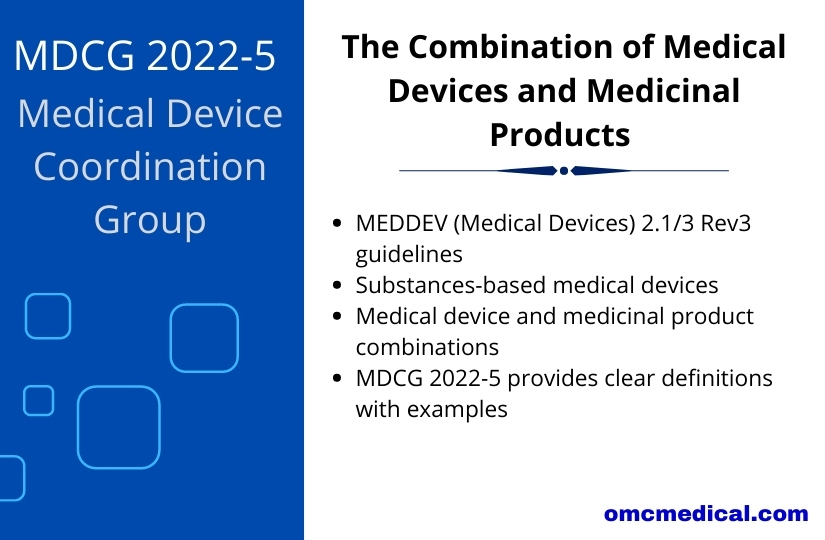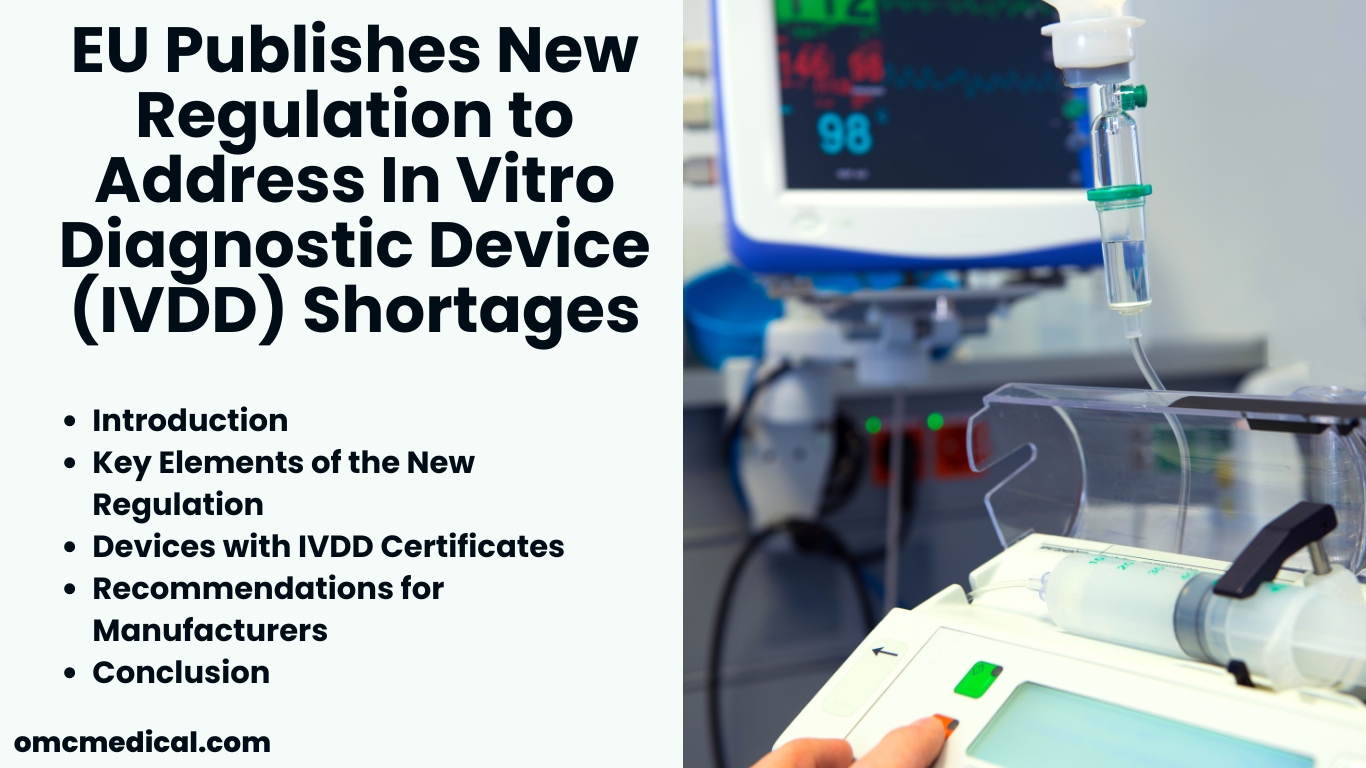This article focuses on the distinctions between the MDD and MDR, considering the terminologies and real-world examples of substance-based devices and combinations of medical and medicinal products.
MEDDEV (Medical Devices) 2.1/3 Rev3 guideline for “Borderline products, drug-delivery products, and medical devices incorporating, by an integral part, an ancillary medicinal substance or with ancillary human blood derivative” got replaced with MDCG 2022-5 ” Guidance on the borderline between medical devices and medicinal products under Regulation (EU) 2017/745 on medical devices”.
The guidance distinguished the following three concepts in MDR.
1. Article 2(1) MDR, first paragraph refers to the ‘Specific medical purpose’ specified by the manufacturer as
- diagnosis, prevention, monitoring, prediction, prognosis, treatment of disease
- diagnosis, treatment, monitoring, alleviation of, or compensation for, disability or injury
- the investigation, modification, or replacement of the anatomy or a physiological or pathological process or state
2. Article 2(1) MDR, second paragraph refers to ‘Principal intended action’, which describes the manufacturer’s labelling and claims based on state-of-the-art scientific data regarding the principal mode of action, on a case-by-case basis like
- the medical devices for the control or support of conception
- products specially intended for the cleaning, disinfection, or sterilization of devices
3. Article 1(6)(b) MDR refers to the ‘Principal mode of action’ by which the product meets its principal intended action, i.e., pharmacological, immunological, metabolic, physical, or other factors.
Substances-based medical devices
A medical device that uses substances as its base contains ingredients approved for use in medical devices and does not carry out its primary intended activity by pharmacological, metabolic, or immunological mechanisms.
Those devices are used equivalently as a medicinal product, for example, ingested or applied to the skin.
In addition to outlining broad guidelines for substance-based medical devices, the guidance offers an explanation and examples for the substances-based devices that fall under two rules according to MDR Annex VIII.
- Rule 3 talks about the medical devices containing a chemical or combination of substances utilized in vitro in direct touch with human cells, tissues, organs, or human embryos before implantation or administration
For example
- IVF or ART (Assisted Reproductive Technology) products without principal pharmacological/metabolic action (substances or mixture of substances)
- IVF cell media without human albumin
- Solutions for the transport of organs for transplantation (that do not achieve their principal intended action via pharmacological, immunological, or metabolic means),
- Rule 21 talks about the medical devices made of substances or mixtures of substances that are meant to be injected into or applied to the skin
For example
- Vaginal lubricants/moisturizing gel
- Salt water used for nose or throat sprays
- Skin treatment formulations
- Eye drops for lubrication
- Ear drop
- Oral administration of medical devices to treat obesity
Medical Device and Medicinal Products combination
The MDR Article 1(8) and Article 1(9) give a helpful flow chart (Fig 1) for medical devices that are intended for use with a medicinal product in a combination product.

What is meant by “integral” is the key concept in MDCG 2022-5 SECTION 4:
- Article 1(8), First Paragraph of MDR, uses the phrase “integral part” to describe components of devices that would be classified as therapeutic items if used independently.
- In the second paragraph of Article 1(8) MDR, the term “integral products” refers to devices that incorporate a material that, if taken separately, would be considered a medicinal product.
When a product is on the market, it must have at least two separate components, one of which is a device that, when connected (for example, physically or chemically), functions as a single unit and comes under integral product.
As an exceptional case, medical devices co-packed with a medicinal product or devices included in the information provided with the medicinal product are not considered integral products if the pertinent combination occurs at the time of administration.
- Devices used to deliver a medicinal product, and the respective medicinal product forms a “single integral product” are mentioned in Article 1(9), second paragraph MDR.
A single integral product comprises at least two constituent elements, one of which is a device and the other is a pharmaceutical, mixed in a way that prevents their intended separation before use.
If the substance accomplishes the primary intended action of the integral product, the entire product is governed in accordance with Directive 2001/83/EC or Regulation (EC) No 726/2004 as a medicinal product.
If the medical device accomplishes the primary intended function, the complete product is governed by the MDR as a medical device containing a medicinal substance with an additional function.
Devices for administering medications, where the medication is provided separately, are not integral products.
MDCG 2022-5 provides clear definitions with examples for the following:
Combinations of medical devices and medicines are regulated as medicinal products.
The MDR states that Directive 2001/83/EC or Regulation (EC) No. 726/2004 governs the entire product but that the relevant general safety and performance standards of Annex I MDR shall apply as far as the safety- and performance-related device characteristics are concerned.
If the device has a CE mark, the conformity assessment results must be included in the marketing authorization dossier, including the variation dossier.
If the dossier does not contain this information, however, and if a notified body would be required to conduct a conformity assessment of the device if used separately, an opinion on the conformity of the device part with the general safety and performance requirements listed in Annex I MDR must be provided. For further guidance, refer to EMA (European Medicines Agency).
For example
- Pre-charged nebulizers with the specific medicinal products
- Pre-filled syringes with the specific medicinal product
- Wound dressings containing anti-bacterial agent
- Root canal fillers incorporating medicinal products
- Patches for transdermal drug delivery
A medical device used to administer medication
Devices designed to administer a medicinal product within the meaning of the MPD fall under this category, even when the device and the medicinal substance are not integrated.
For example
- Jet injectors
- Port systems
- Implantable infusion pumps
- Drug delivery pumps
- Spacers intended for meters dose inhalers
Medical devices with an ancillary medicinal product built in as a component
The MDR outlines the situation in which medical devices contain a substance that, if used alone, would be considered a medicinal product under Article 1 of the MPD, including a medicinal product made from human blood or human plasma, with an action unrelated to the device’s intended purpose which includes herbal medicinal products too.
For example
- Bone void fillers containing growth factors
- Condoms coated with spermicides
- Liquid wound dressing containing the anti-microbial agent
- Catheters coated with heparin or an anti-microbial agent
Medical devices that include herbal products
- Clove Oil (Caryophylli aetheroleum) – has antiseptic, analgesic, and sedative properties.
- Thymus vulgaris (Thyme) – disinfectant, antiseptic and expectorant properties
- Lavandula angustifolia (Lavender) – antiseptic properties
Medical devices that include human blood or its derivative
- Culture media used in IVF containing human albumin solution
- Haemostatic agent/matrix containing human thrombin
Annex VIII, Rule 14 states that ‘All devices incorporating, as an integral part of a substance which, if used separately, can be considered to be a medicinal product, as it is defined in point 2 of Article 1 of Directive 2001/83/EC, including medicinal product which derived from human blood or human plasma, as defined in point 10 of Article 1 of that Directive 2001/83/EC, and that has an action ancillary to that of the devices, are classified as class III’.
Furthermore, Annex IX section 5.2(a) requires that ‘Where a device incorporates, as an integral part of a substance which, if used separately, may be considered to be a medicinal product within the meaning of the point 2 of Article 1 of Directive 2001/83/EC, including a medicinal product that derived from human blood or human plasma and that has an action ancillary to that device, the quality, safety and usefulness of substance shall be verified by analogy with the specific methods in Annex I to Directive 2001/83/EC’.
FAQs
What is EMA?
The European Medicines Agency (EMA) is an agency of the European Union which regulates the evaluation and supervision of medicinal products. Its main responsibility is to protect and promote public and animal health.
What is a combination product?
Combination products are two or more components, such as a drug and a device, a drug and a biological, a biologic and a device, or a drug and a device and a biological, must be integrated, mixed, or combined in some other way to be considered a single product.
Is UDI (Unique Device Identification) applicable for medicinal products incorporating medical devices?
UDI-related MDR duties are not necessary for a DDC (Drug Device Combination) covered by the regulation of the medicinal products. Therefore, the package of such a DDC should not be subjected to a device part-related UDI. Additional information is provided in the MDCG 2019-2 guidance on the application of UDI rules to device-part of products referred to in Articles 1(8), 1(9) and 1(10) of Regulation 2017/745.
When a DDC’s device component is CE-marked, the integral DDC’s product labelling should adhere to the labelling specifications for medicinal products as specified in the QRD (working group on Quality Review of Documents) templates. There is no need to remove a UDI that has already been physically marked on a device part. The labelling or outside packaging of the pharmaceutical product should not include the UDI.
Disclaimer: Regulations/legislations are subjected to changes from time to time and the author claims no responsibility for the accuracy of information.











